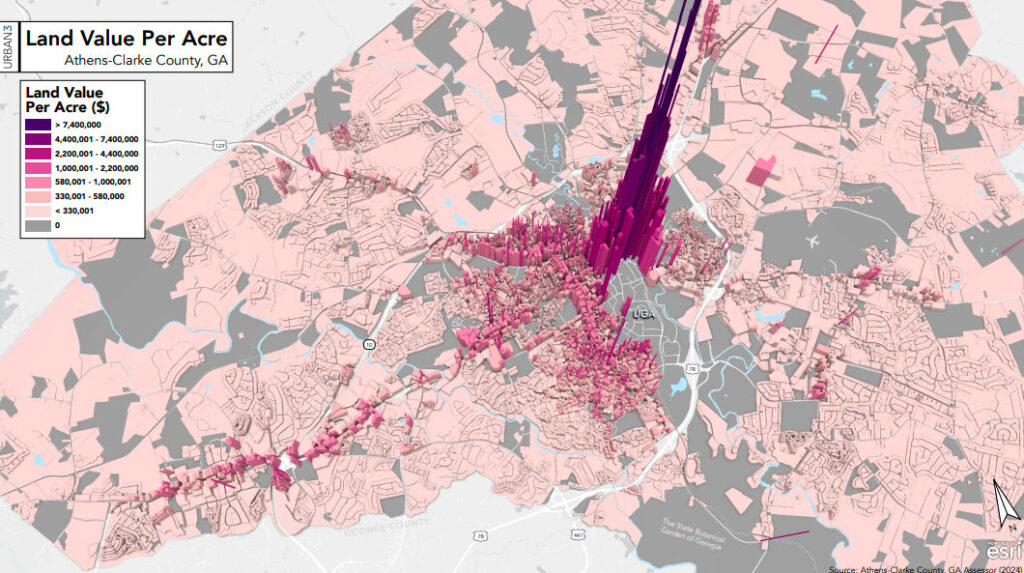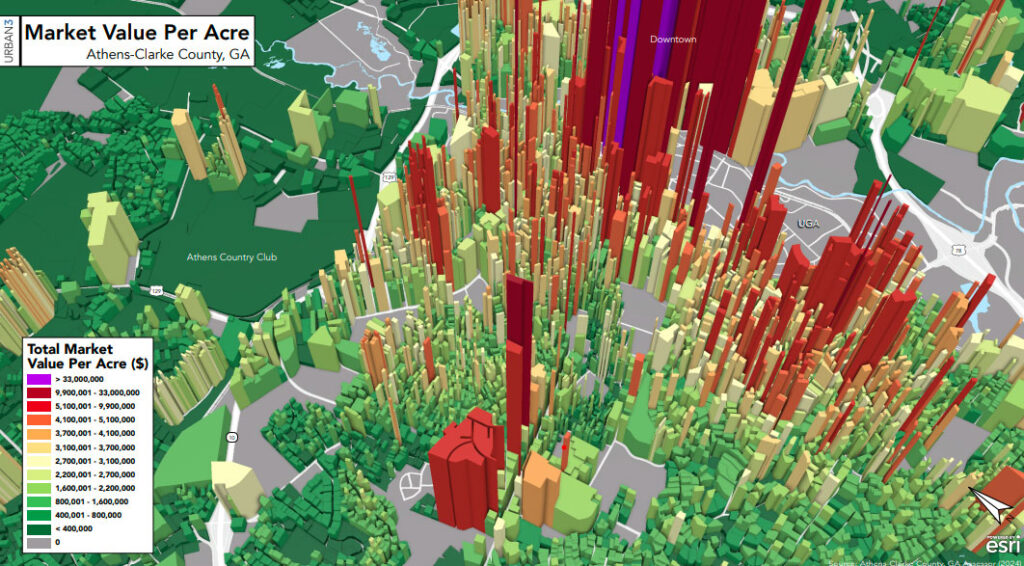The massive house in Five Points that Kirby Smart recently put on the market is valued by the tax assessor at $3.1 million. A typical bungalow in Boulevard is worth $650,000. Which is more valuable? The answer might surprise you.
The Lyndon Avenue house, which sits on about a tenth of an acre, is actually more productive, with a value of $6.9 million per acre. Smart’s mansion is worth $1.6 million per acre. In other words, denser development produces more tax bang for the land than large suburban lots.
The same goes for commercial development. A big-box store on Atlanta Highway produces $144,000 in sales and property tax revenue per acre, whereas downtown acreage yields an average of $558,000 annually, according to Joe Minicozzi, an Asheville urban planner who specializes in visualizing data related to density, land value and tax revenue. He visited Athens recently to give several presentations on Athens’ first future land use map update in 25 years.
With Athens projected to add 30,000 people by 2050, the Athens-Clarke County Planning Department hired Minicozzi’s firm Urban3 to provide a data-driven perspective on why it’s preferable to allow some modest vertical growth than to accommodate a rising population by sprawling outwards. The third alternative is to do nothing, allowing housing costs to continue to escalate because demand exceeds supply, and pricing more people out of the city.
“The average Walmart consumes more police services than it pays in property taxes,” Minicozzi said, explaining that “parking brings down value” while “density creates value.” So does good architecture, as opposed to “throwaway trash.”
Meanwhile, downtown makes up just 0.2% of Athens’ land area but generates 8% of its tax revenue. “That is astounding,” Minicozzi told ACC commissioners at a work session. “This is your most fertile soil producing the most wealth.”

Overall, 20% of Athens’ land subsidizes the other 80%. Low-density strip malls and subdivisions are money losers for the local government, while higher-density single-family homes and commercial developments, multifamily and especially mixed-use pay the bills.
Much of that low-density development happened post-World War II, when cities all over the country changed the way they grew to accommodate vast numbers of automobiles. “We were sold a bill of goods, and no one really penciled [the cost] out,” Minicozzi said.
Property doesn’t need to be built up to a 10-story luxury student apartment building to bring in net revenue, though. One- to three-story commercial buildings like those in Five Points and Normaltown are also incredibly valuable, worth millions of dollars per acre. In addition to the tax benefits, those areas tend to feature locally owned small businesses that pay higher wages than chains and are more likely to hire other local businesses to handle their accounting or marketing, for example, Minicozzi said.
Farmland is generally neutral, not creating much revenue nor costing much in services. “An ear of corn doesn’t call the police,” Minicozzi said. Industries tend to be a major drain, primarily because of the massive amounts of water they consume, but the tradeoff is the jobs they create, he said.
About 17% of Athens is tax exempt, which Minicozzi said is actually on the low side despite the presence of the University of Georgia. However, 56% of the most valuable property downtown is nontaxable—owned by churches or the ACC government—which he said should make city officials think twice about taking any more off the tax rolls. The commission recently rejected an opportunity to put downtown property back on the tax digest by allowing First United Methodist Church to tear down the Saye Building rather than accept an offer by private investors to buy it.
All of this matters because the ACC government has been underfunding infrastructure maintenance, particularly roads, to the tune of $29 million a year, and the bill will eventually come due. “You can kick the can down the road, but it’s still going to be there,” Minicozzi told the mayor and commission.

Higher density development could help close that gap. Minicozzi’s firm, Urban3, looked at potential developments at the Willowood shopping center, on South Milledge Avenue and along Firefly Trail, and calculated that five developments alone could net the county $3 million.
The idea of higher density is causing heartburn among some suburban residents, though. “We don’t need any more density in Athens,” Republican activist Michael McLendon told Minicozzi at a town hall meeting. “We’re choking on density already.”
Eastside residents raised concerns at a town hall meeting at Hilsman Middle School last month. “There has been some conversation out there about single-family homes and allowing quadruplexes, multifamily to be built,” said former commissioner Andy Herod, a Green Acres resident. That’s fine if it’s new development, he added, but not in established neighborhoods.
The current version of the land use map changes the zoning on less than 6% of Athens’ land and leaves single-family neighborhoods untouched, although there was sharp debate on an advisory board about whether to abandon single-family zoning, according to ACC Planning Director Bruce Lonnee. “We’re not trying to be Minneapolis,” a city that recently did so, he said. But the map leaves the door open for a future conversation about where to allow “missing middle” housing like duplexes and accessory dwelling units (aka granny or in-law flats).
The map would focus the coming growth along the county’s main roads, ideally allowing residents to avoid car trips by making it easier to walk to the store or the doctor’s office instead. “A lot of our corridors are overlooked. They’re just places just to get to the next place,” Lonnee said. “We’re trying to get people to live on these corridors and not have them be just for cars.”
Some in the Black community are also suspicious, raising the specter of gentrification and displacement. “It’s too close to urban renewal for me,” said Commissioner Ovita Thornton, referring to a time when cities tore down Black neighborhoods like Linnentown. “That’s where my folks are panicking.”
Lonnee said the proposed land use map wouldn’t displace anyone because people aren’t currently living in the areas targeted for more density—primarily aging commercial parcels and underused parking lots. “We’ve got all kinds of land that can support more development and not displace anybody,” he told Thornton.
Minicozzi responded to those concerns by saying his study was based on economics, not sociology. “There’s a lot of trauma, there’s a lot of past history going on that needs to be raised to the surface,” he said, adding that he was merely providing data to help guide the community’s decision-making.
The planning department is likely to present the future land use map to the mayor and commission for approval in August or September, Lonnee said. More information about the map is available at accgov.com/compplan.
Like what you just read? Support Flagpole by making a donation today. Every dollar you give helps fund our ongoing mission to provide Athens with quality, independent journalism.










